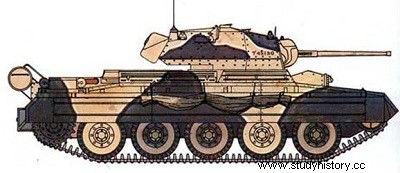
Crusader I, II and III
Type :tank cruiser.
Crew :5 men (Mark I); 4 or 5 (Mark II); 3 (Mark III).
Armament: a 2 pounder cannon and two 7.92 mm Besa machine guns (Crusader I); a 2-pounder gun and one or two 7.92mm Besa (Crusader ID; a 6-pounder gun and a 7.92mm Besa (Crusader III).
Shielding
:minimum 7 mm and maximum 40 mm (Crusader I); minimum 7mm and maximum 49mm (Crusader II); minimum 7 mm and maximum 51 mm (Crusader III).
Dimensions
length :5.99 m;
width :2.64 m;
height :2.23 m.
Weight in combat order :17.2 t (Crusader I and 18; 20 t (Crusader III).
Ground pressure :1.04 kg/cm2.
Engine :Nuffield Liberty 12 cyl. in-line water-cooled gasoline engine, developing 340 hp.
Performance:
road speed speed:43.2 km/h;
range :160 km;
vertical obstacle :0.685 m;
clean cut :2.59m;
slope :60%.
Service time :in the British army from 1939 to 1943.
The Crusader was to a large extent an improvement of the Covenanter which it more or less resembled outwardly. The design of the Covenanter dated from the pre-war period, studies having begun in 1937; the craft was similar to the Cruiser Mark IV or A13. The Crusader showed the same general design as these other cruisers but it was cataloged as a heavy tank, a specification difficult to meet within the imposed weight and size limits.
Similarly, the designation was curious for a tank whose main armament was limited to a 2-pounder gun. However, the specification showed that the authorities understood the shortcomings of earlier models. These lacked armour, as well as firepower, but no one could do anything about it in 1939.
The Crusader was manufactured by a consortium under the direction of Nuffield Mechanizations Ltd. and the total production reached 5,300 units.
The hull was similar to that of the Covenanter, with a long quarterdeck and a well-raked glacis. The Christie undercarriage was very similar on both models except, on the latest model, for the additional wheel and the springs housed inside the hull.
This suspension was the best quality of the Crusader and allowed it speeds well above the official figure of 43.2 km/h. In North Africa, drivers and mechanics opened the speed regulators wide to let go of the Liberty engine, which sometimes pushed the tank up to 64 km/h. The Christie wheels then held up very honorably and even without shaking the crew too much, which usually suffered much less than the engine.
The hull was according to tradition, divided into three compartments and in the first two versions, the driver shared the front position with the servant of the cash machine gun. The Crusader I mounted this weapon under a small auxiliary turret located on the front plate but this configuration gave way to a ball joint mounting to be purely and simply abandoned on the Mark III which lacked space for the storage of supplies, in particular ammunition. Speaking of space, the combat chamber under the turret had little to
offer.
The tank commander was just as narrower than his men, because he had to simultaneously command the vehicle, load the gun and often even serve the radio:eternal defects of a two-seater turret! The antiquated but time-tested Nuffield Liberty was basically a World War I aviation engine that had been reduced in power from 400 to 340 hp. The first Crusaders had major engine problems caused mainly by the cooling system. The ventilation system deteriorated easily and the air filters were difficult to clean, but experience and ingenuity came to remedy this sad state of affairs and soon the engine gave complete satisfaction.
It is certain that the tank was sent to active service as soon as possible, before all its youthful illnesses had been cured and, during its first engagement in June 1941, Operation "Battleaxe", the Crusaders lost to the combat were fewer than those that fell into enemy hands after breaking down. Nevertheless, the tank continued its career, took part in all the major operations in the desert campaign and on the day of El Alamein, the Crusader III was in line with its 6-pounder gun, with a larger, more flattened and frankly unsightly. This same mantlet could also be adapted to a 3-inch Close Support howitzer (direct support), but this modification was not widespread.
By the end of the North African campaign, the Crusader was obsolete. Some took part in the battle of Italy and some Crusader hulls, converted into anti-aircraft vehicles and artillery tractors, saw fire in North-West Europe In the desert the tank's speed earned it the esteem of the troop but its shielding was always too thin and its armament always too weak.
